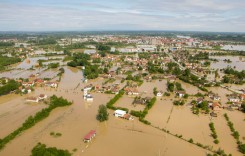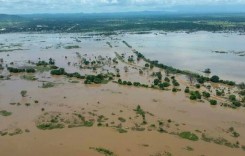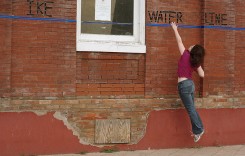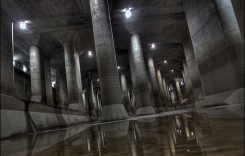In the fourth article in the series “A New Approach to Storm-Water Management and Flood Reduction“, Ed Hill looks at Low Impact Development (LID) and ‘green infrastructure’ (GI) in North America.

Similar in concept to SuDS in the UK (see examples of cases studies “Slowing the Flow” and Manor Fields Park), in the United States of America the concept of Low Impact Development (LID), which is said to have begun in Prince George’s County, Maryland, in 1990, was initiated as an alternative to conventional stormwater best management practices (BMP’s). In the USA, conventional BMP’s were found to fall short of EPA-mandated water quality goals.
What is LID?
According to the US Environment Protection Agency (EPA), the term LID refers to “systems and practices that use or mimic natural processes that result in infiltration, evapotranspiration or use of stormwater in order to protect water quality and associate aquatic habitat”. The term LID is usually found in close association with the term ‘green infrastructure’ (GI), which is used by the EPA to refer to “the management of wet weather flows using these (LID) processes, and… to the patchwork of natural areas that provide habitat, flood protection, cleaner air and cleaner water”.
In addition to diverting stormwater around built features as with conventional stormwater management, rather than concentrating flows, LID aims to divert runoff to multiple on-site locations, slowing it in order to permit filtration of pollutants and promoting groundwater recharge and evaporation, thereby reducing the volume of water leaving the site. Thus LID/GI differs from conventional stormwater management in that the latter seeks to concentrate runoff and to direct it off the property in a ‘single-point’ channel, usually a stormwater culvert or pipe.
According to the Contech Engineered Solutions website, the basic concept in LID is to model nature and manage rainfall at source, by “sequenced implementation of runoff prevention strategies, runoff mitigation strategies, and finally, treatment controls to remove pollutants.”
The article goes on to give “5 core requirements when it comes to designing for LID:
1. Conserve natural areas wherever possible (don’t pave over the whole site if you don’t need to).
2. Minimize the development impact on hydrology.
3. Maintain runoff rate and duration from the site (don’t let the water leave the site).
4. Scatter integrated management practices (IMPs) throughout your site – IMPs are decentralized, microscale controls that infiltrate, store, evaporate, and/or detain runoff close to the source.
5. Implement pollution prevention, proper maintenance and public education programs.”
Landscape features (also known as Best Management Practices, BMPs) used to achieve these goals include:
• Bio-swales
• Bio-retention areas
• Check Dams
• Vegetative Buffer Strips
• Detention Ponds
US Legislative Context
LID is promoted by the EPA as a means to meet the goals of the Clean Water Act. As an extension of this legislation, the National Pollutant Discharge Elimination System (NPDES) requires that any facility that discharges pollutants into any water body in the USA from any point source, such that it disturbs an area greater than one acre (4,400m²) – or less than an acre if part of a development larger than one acre – must obtain a permit, for which a Storm Water Pollution Prevention Plan (SWPPP) for construction and post-construction activity is a pre-requisite. The water body may be any natural drainage course, stream, river, lake or the ocean, whilst a point source would be any point on the boundary of a property.
The EPA uses a very broad definition of the term ‘pollutant’, such that, according to KTUA consultants, “it is safe to say, if stormwater leaves your site, it contains ‘pollutants’ in one form or another”. Whilst requirements for permit application vary across authorities, depending on location, conditions of permits usually require the implementation of LID BMP’s (or IMP’s – Integrated Management Practices) to reduce or prevent the discharge of pollutants from the development site.

Costs Associated with LID/GI
A common question is whether LID-based projects will mean greater expense compared to development using conventional stormwater management practices – in terms of higher design and construction costs, and whether the additional cost, if there is such, will be justified.
In 2013 the EPA published an analysis of the economic benefits of LID-GI projects (PDF), containing several case studies. In the document, the EPA states that, even though “many entities have begun to implement LID and GI approaches for stormwater management, research shows that a relatively small percentage of jurisdictions have conducted economic analyses of their existing or proposed programs.”
It further states that “(m)anaging stormwater runoff solely through traditional “grey” infrastructure systems can present a variety of challenges, including high construction, maintenance, and repair costs; increasing combined sewer overflow events; and the introduction of pollutants into source waters. These problems are increased as population and development continue to increase and new challenges, such as changing weather patterns, increasing energy costs, new environmental concerns, and ageing water infrastructure arise. As the complexity and magnitude of these issues increase, states, cities, and water resource managers increasingly have recognized that a new, integrated approach to stormwater management—one that focuses on sustainability and benefits for multiple stakeholders—will be needed to help ensure that the nation can provide the quality and quantity of water demanded in the future.”
The document analyses 13 case studies where agencies have undertaken economic studies of the benefits versus costs of their LID-GI projects. In the coming weeks, further articles in our “A New Approach to Storm-Water Management and Flood Reduction“ series will take a look at some of the case studies which contain or focus on flood attenuation.



neighborhood of Seattle, WA. Source: Abby Hall, US EPA








